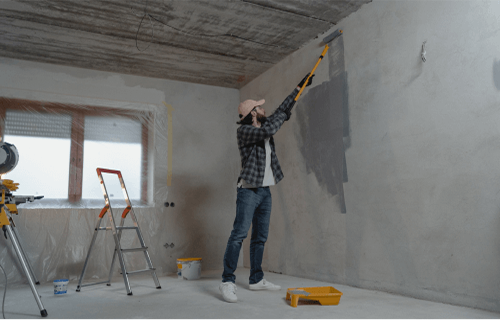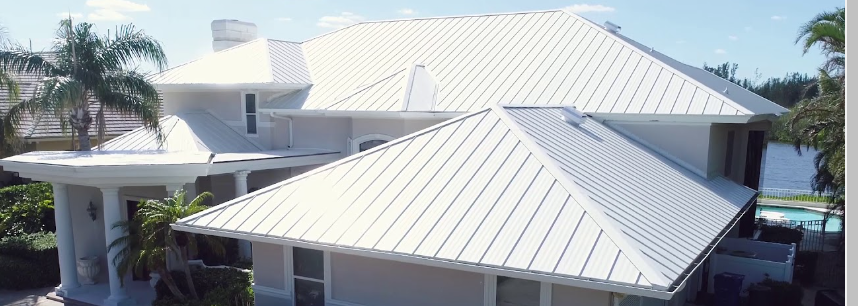Roof Replacement
Our Services
Trust the Experience

Roof replacement
Roof replacement is the process of removing an existing roof and installing a new one. This can be necessary due to a variety of reasons, such as damage caused by weather events, wear and tear over time, or a desire to upgrade to a more durable or energy-efficient material.
The process of roof replacement typically involves several steps, including:
Inspection: A professional roofing contractor will inspect the roof to determine the extent of the damage and assess whether replacement is necessary.
Removal: The old roof is removed, typically using tools such as a pry bar or scraper.
Repair: Any damage to the underlying structure, such as rot or mold, is repaired before the new roof is installed.
Installation: The new roof is installed, typically starting with a layer of underlayment followed by the roofing material itself.
Clean up: The job site is cleaned up, including the removal of all old roofing materials and debris.
Roof replacement can be a complex and expensive process, but it is important to ensure the safety and longevity of your home or building. It is important to work with a qualified and experienced roofing contractor to ensure that the job is done correctly.


Roof Repair
Roof repairs involve fixing any damages or issues that have occurred to a roof, without replacing the entire roof. Roof repairs can range from minor fixes, such as replacing a few shingles or repairing a leak, to more significant repairs that require the attention of a professional roofing contractor.
Some common types of roof repairs include:
Fixing leaks: Leaks can be caused by a variety of issues, such as damaged shingles, cracked flashing, or damaged roof vents. Roof leaks should be addressed promptly to prevent further damage to the roof and the interior of the building.
Shingle replacement: Shingles can become damaged over time due to exposure to weather and other elements. Replacing damaged shingles can help prevent leaks and prolong the life of the roof.
Flashing repair: Flashing is a material that is used to seal joints and prevent water from entering the roof. If flashing becomes damaged or comes loose, it can cause leaks.
Gutters and downspouts: Damaged gutters and downspouts can cause water to accumulate on the roof, leading to leaks and other issues.
Vent repair: Vents help to ventilate the roof and prevent moisture buildup. Damaged or improperly installed vents can cause problems with moisture and ventilation.
It is important to address any roof repairs promptly to prevent further damage and prolong the life of the roof. Working with a qualified and experienced roofing contractor can help ensure that repairs are done correctly and effectively.


Leak Repair
Roof leak repairs involve fixing any damage or issues that have caused water to penetrate into the interior of a building through the roof. Roof leaks can be caused by a variety of factors, such as damaged or missing shingles, cracked flashing, or improperly sealed roof penetrations.
The process of repairing a roof leak typically involves several steps, including:
Inspection: A professional roofing contractor will inspect the roof to determine the cause of the leak and the extent of the damage.
Identifying the source: The contractor will identify the source of the leak, which may involve using special tools such as moisture meters or thermal imaging cameras to locate the source of the water intrusion.
Repairing the damage: Once the source of the leak has been identified, the contractor will repair any damaged shingles, flashing, or other components that are contributing to the problem.
Sealing penetrations: The contractor may need to seal any roof penetrations, such as vents or chimneys, to prevent water from entering through these areas.
Testing for leaks: After the repairs are complete, the contractor will test the roof for leaks to ensure that the problem has been resolved.
It is important to address roof leaks promptly to prevent further damage to the roof and the interior of the building. Working with a qualified and experienced roofing contractor can help ensure that the repairs are done correctly and effectively.


Roof Installations
.Roof installation involves the process of installing a new roof onto a building, either as a replacement for an old or damaged roof or as part of a new construction project. Roof installation typically involves several steps, including:
Inspection: A professional roofing contractor will inspect the existing roof or the plans for the new construction project to determine the appropriate materials and techniques needed for the new roof.
Material selection: The contractor will work with the property owner or the builder to select the appropriate roofing materials, such as shingles, tiles, metal, or a flat roof membrane, based on the building’s design, location, and budget.
Preparation: The contractor will prepare the roof deck by removing any old roofing materials, repairing any damaged areas, and installing an underlayment to provide an additional layer of protection against water and other elements.
Installation: The roofing materials are then installed, starting at the bottom of the roof and working upwards. This process may involve cutting and fitting the roofing materials to the roof’s shape and size.
Finishing touches: Once the roofing materials are in place, the contractor will install any necessary flashing, vents, or other roof accessories to ensure proper ventilation and drainage.
Roof installation is a complex process that requires specialized knowledge and equipment. It is important to work with a qualified and experienced roofing contractor to ensure that the job is done correctly and safely. A properly installed roof can provide many years of protection and energy efficiency for the building.


Roof Title
Roof tiles are a common roofing material that is made from various materials such as clay, concrete, or slate. They are popular for their durability, longevity, and aesthetic appeal.
The installation process for roof tiles typically involves several steps, including:
Roof deck preparation: The roof deck is prepared by installing a layer of underlayment over the sheathing to provide a water-resistant barrier.
Tile layout: The tiles are laid out on the roof in the desired pattern, and any necessary cuts are made to ensure a proper fit.
Battens installation: Wooden or metal battens are installed over the underlayment to provide support for the tiles.
Tile installation: The tiles are secured to the battens using nails or clips. The installation process may involve interlocking or overlapping the tiles to ensure proper water drainage.
Finishing touches: Once the tiles are in place, any necessary flashing, ridge tiles, or other roof accessories are installed to provide additional protection and ventilation.
Roof tiles require proper maintenance and repair to ensure their longevity and effectiveness. Regular inspections and cleaning can help prevent damage from weather, debris, or moss growth. If damage occurs, repairs should be done promptly to prevent further damage and water penetration. It is important to work with a qualified and experienced roofing contractor for tile roof installation, maintenance, and repair.


Metal Roof
Metal roofs are a type of roofing material that is made from various types of metal, such as steel, aluminum, or copper. They are popular for their durability, longevity, and energy efficiency.
The installation process for metal roofs typically involves several steps, including:
Roof deck preparation: The roof deck is prepared by installing a layer of underlayment over the sheathing to provide a water-resistant barrier.
Trim installation: Metal trim is installed along the edges of the roof to provide a finished look and to protect against water penetration.
Panels installation: The metal panels are installed horizontally or vertically, depending on the desired design. The panels are secured to the roof deck using screws or clips.
Finishing touches: Once the panels are in place, any necessary flashing, ridge caps, or other roof accessories are installed to provide additional protection and ventilation.
Metal roofs require proper maintenance and repair to ensure their longevity and effectiveness. Regular inspections and cleaning can help prevent damage from weather, debris, or rust. If damage occurs, repairs should be done promptly to prevent further damage and water penetration. It is important to work with a qualified and experienced roofing contractor for metal roof installation, maintenance, and repair.
Roof Inspection
Scheduling An Appointment
Lorem ipsum dolor sit amet, consectetur adipiscing elit. Ut elit tellus, luctus nec ullamcorper mattis, pulvinar dapibus leo.